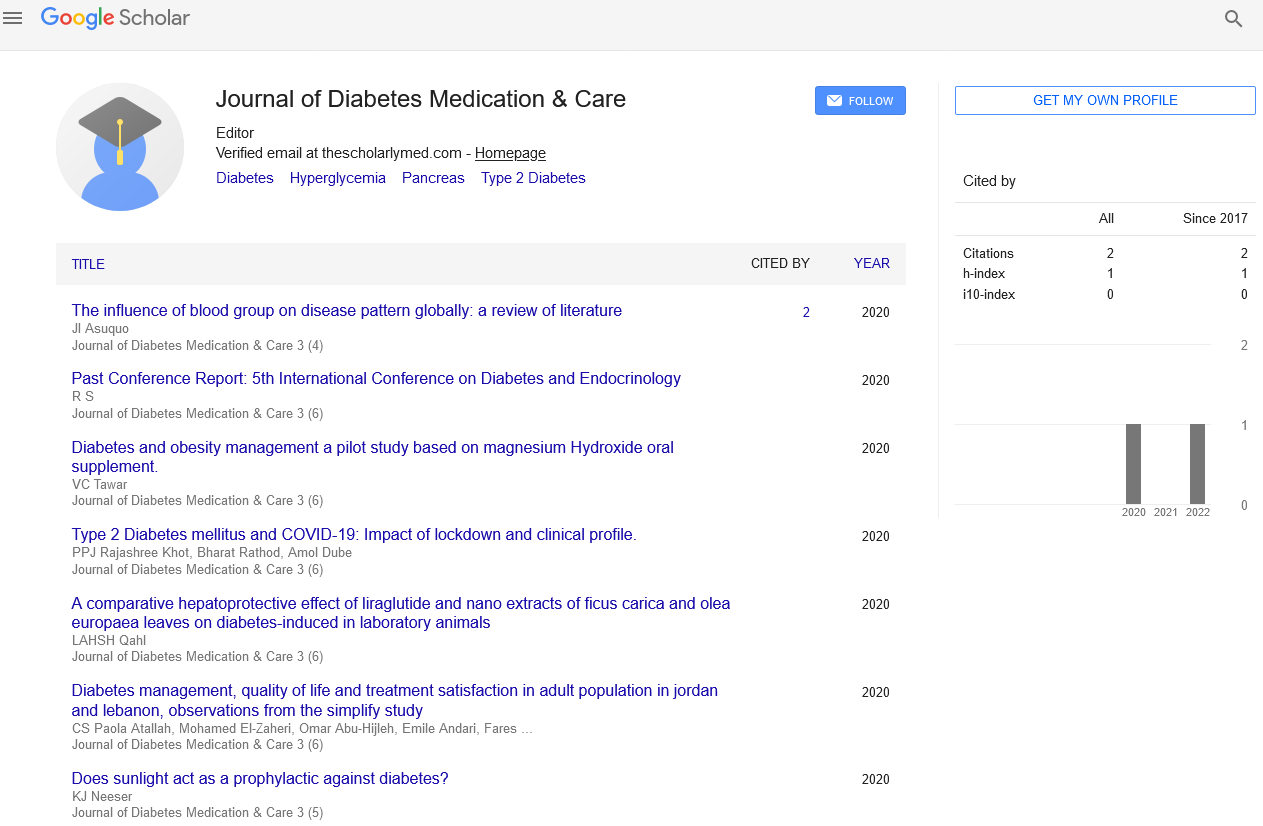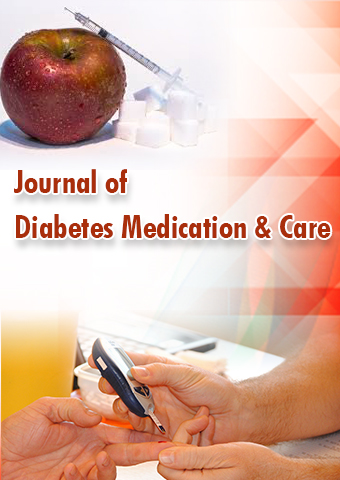Opinion Article - Journal of Diabetes Medication & Care (2024) Volume 7, Issue 5
Oral Insulin: A Revolutionary Approach to Diabetes Management
- Corresponding Author:
- Carolina Gutire
Department of Internal Medicine, Aristotle University, Thessaloniki, Greece
E-mail: gutirezcarolia@gmail.com
Received: 03-Sep-2024, Manuscript No. JDMC-24-148350; Editor assigned: 06-Sep-2024, PreQC No. JDMC-24-148350 (PQ); Reviewed: 20-Sep-2024, QC No. JDMC-24-148350; Revised: 10-Oct-2024, Manuscript No. JDMC-24-148350 (R); Published: 17-Oct-2024, DOI: 10.37532/JDMC.2024.7(5).255-257
Introduction
Diabetes is a global health challenge, affecting over 537 million adults in 2021. The condition primarily arises from the body’s inability to produce or utilize insulin effectively, leading to elevated blood glucose levels. While injectable insulin has been a cornerstone of diabetes management for decades, the quest for an oral form has captivated researchers and healthcare professionals alike. This article delves into the development of oral insulin, its potential benefits, challenges, and the future it holds for diabetes management.
Description
The importance of insulin therapy
Dried Insulin therapy is vital for individuals with Type 1 Diabetes (T1D) and often necessary for those with advanced Type 2 Diabetes (T2D). Traditionally, insulin is administered via subcutaneous injections, which can be uncomfortable, inconvenient, and lead to issues with patient compliance. The need for multiple injections per day can also be a psychological barrier for many patients. These challenges underscore the importance of developing an oral formulation that could simplify treatment and enhance adherence.
The science behind oral insulin
The journey to creating an oral form of insulin is fraught with scientific complexities. Insulin is a peptide hormone that is sensitive to digestion and requires protection from the acidic environment of the stomach and enzymatic degradation in the gastrointestinal tract. Researchers have explored various strategies to overcome these barriers, focusing on innovative delivery systems that can effectively transport insulin through the digestive system and into the bloodstream.
Key approaches in development
Nanoparticle carriers: Researchers are investigating the use of nanoparticles to encapsulate insulin. These tiny particles can protect insulin from degradation and facilitate its absorption through the intestinal wall.
Microneedle patches: Although not a traditional oral formulation, microneedle patches provide a minimally invasive alternative to injections. These patches can deliver insulin painlessly through the skin and may be considered a bridge between oral and injectable forms.
Chemical modifications: Scientists are working on chemically modifying insulin to enhance its stability and absorption when taken orally. This includes altering its structure to withstand the harsh conditions of the gastrointestinal tract.
Biopolymer coatings: Employing biopolymers to coat insulin molecules can help shield them from stomach acids. These coatings can dissolve in the more neutral environment of the intestines, allowing insulin to be released and absorbed effectively.
Recent developments in oral insulin
Several promising oral insulin formulations are currently in various stages of research and clinical trails. Notably:
Oral insulin for type 1 diabetes: Some studies are focusing on the use of oral insulin as a potential adjunct therapy for T1D. Early research indicates that it may help improve glycemic control, particularly in the postprandial phase.
Oral insulin for type 2 diabetes: In the case of T2D, oral insulin may serve as a bridge for patients who are hesitant to start insulin therapy. Clinical trials have shown that oral insulin can effectively reduce HbA1c levels, indicating better long term glucose control.
Combination therapies: Research is also exploring the potential of combining oral insulin with other antidiabetic medications, such as metformin. This could maximize therapeutic benefits while minimizing side effects.
Potential benefits of oral insulin
Improved patient compliance: One of the most significant advantages of oral insulin is the potential to enhance patient compliance. Many individuals are reluctant to initiate insulin therapy due to the fear of injections. An oral formulation could alleviate this barrier, leading to more consistent treatment adherence.
Enhanced quality of life: Oral insulin could significantly improve the quality of life for individuals with diabetes. The convenience of taking a pill rather than managing injections can reduce anxiety and stigma associated with diabetes management, making it easier for patients to integrate their treatment into daily life.
Flexible dosing: Oral insulin could allow for more flexible dosing schedules, as patients may find it easier to adjust their medication intake around meals and activities compared to the rigidity of injection schedules.
Reduced risk of injection related issues: By eliminating the need for injections, oral insulin may reduce the risk of complications associated with needle use, such as injection site infections, lipodystrophy, and needle anxiety.
Challenges and considerations
Despite the potential benefits, several challenges remain in the development and implementation of oral insulin:
Efficacy and bioavailability: Ensuring that oral insulin is both effective and bioavailable remains a significant hurdle. Researchers must develop formulations that not only protect insulin from degradation but also allow for sufficient absorption to achieve therapeutic levels in the bloodstream.
Cost and accessibility: The development of innovative drug delivery systems can be costly, and these expenses may be passed on to patients. Ensuring that oral insulin is affordable and accessible to a broad population will be essential for its success.
Regulatory hurdles: As with any new pharmaceutical product, oral insulin formulations must undergo rigorous testing and regulatory scrutiny to ensure their safety and efficacy. This process can be time-consuming and costly.
Patient education: Transitioning to oral insulin will require comprehensive patient education to ensure that individuals understand how to integrate it into their diabetes management plan effectively.
Future prospects
The future of oral insulin appears promising, with ongoing research and clinical trials aimed at addressing the current challenges. As scientists continue to explore innovative delivery mechanisms, the dream of an effective oral insulin formulation may soon become a reality.
Integration with digital health: The rise of digital health technologies offers exciting opportunities for oral insulin management. Apps that track blood glucose levels, dietary intake, and medication adherence can provide valuable data to both patients and healthcare providers. This information can help optimize insulin dosing and improve overall diabetes management.
Personalized medicine: As the field of personalized medicine evolves, oral insulin may be tailored to meet individual patient needs. Genetic factors, lifestyle, and coexisting health conditions could influence the choice of oral insulin formulations, leading to more effective and personalized treatment plans.
Conclusion
Oral insulin represents a revolutionary approach to diabetes management, promising to enhance patient compliance, quality of life, and overall glycemic control. While significant challenges remain in its development, the potential benefits make it a worthwhile pursuit. As research progresses, the dream of taking insulin in pill form could soon become a reality, transforming how millions of people manage diabetes and enabling a more integrated approach to chronic disease management. The future of oral insulin is bright, and it may redefine the landscape of diabetes care for years to come.

